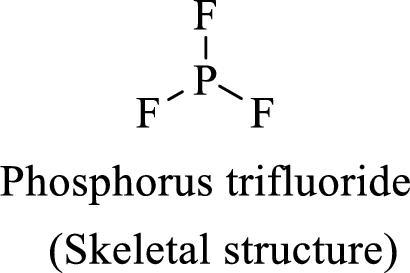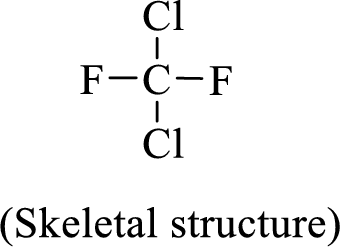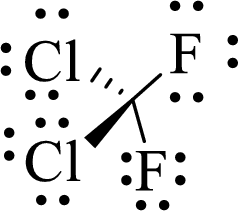
Concept explainers
Draw the Lewis structure and name the molecular geometry for these molecules.
- a. PF3
- b. HCN (carbon is the central atom)
- c. CF2Cl2 (carbon is the central atom)
(a)
Interpretation:
The Lewis structure and name of molecular geometry should be provided for the given molecule
Concept Introduction:
Lewis structures are diagrams that represent the chemical bonding of covalently bonded molecules and coordination compounds.
The chemical bonding present in covalently bonded molecules and in coordination compounds are represented using Lewis structures.
It is also known as Lewis dot structures which represents the bonding between atoms of a molecule and the lone pairs of electrons that may exist in the molecule.
The Lewis structure is based on the concept of the octet rule so that the electrons shared in each atom should have 8 electrons in its outer shell.
Sometimes the chemical bonding of a molecule cannot be represented using a single Lewis structure. In these cases, the chemical bonding are described by delocalization of electrons and is known as resonance.
All the possible resonance structures are imaginary whereas the resonance hybrid is real.
These structures will differ only in the arrangement of the electrons not in the relative position of the atomic nuclei.
Lewis structure for any molecule is drawn by using the following steps,
First the skeletal structure for the given molecule is drawn then the total number of valence electrons for all atoms present in the molecule is determined
The next step is to subtract the electrons present in the total number of bonds present in the skeletal structure of the molecule with the total valence electrons such that considering each bond contains two electrons with it.
Finally, the electrons which got after subtractions have to be equally distributed such that each atom contains eight electrons in its valence shell.
Molecular geometry is the shape of a molecule predicted by considering only bond pair of electrons.
Geometry of different type of molecules with respect to the number of electron pairs are mentioned below,
Explanation of Solution
The Lewis electron dot structure for given molecules are determined by first drawing the skeletal structure for the given molecules, then the total number of valence electrons for all atoms present in the molecules are determined.
The next step is to subtract the electrons present in the total number of bonds present in the skeletal structure of the molecule with the total valence electrons such that considering each bond contains two electrons with it.
Finally, the electrons which got after subtractions have to be equally distributed considering each atom contains eight electrons in its valence shell.
The given moleucle is

Thus, the Lewis structure of given compound is,

Since the molecule has three bond pairs of electrons and a lone pair of electron on its central atom, its molecular geometry is triogonal pyramidal..
(b)
Interpretation:
The Lewis structure and name of molecular geometry should be provided for the given molecule
Concept Introduction:
Lewis structures are diagrams that represent the chemical bonding of covalently bonded molecules and coordination compounds.
The chemical bonding present in covalently bonded molecules and in coordination compounds are represented using Lewis structures.
It is also known as Lewis dot structures which represents the bonding between atoms of a molecule and the lone pairs of electrons that may exist in the molecule.
The Lewis structure is based on the concept of the octet rule so that the electrons shared in each atom should have 8 electrons in its outer shell.
Sometimes the chemical bonding of a molecule cannot be represented using a single Lewis structure. In these cases, the chemical bonding are described by delocalization of electrons and is known as resonance.
All the possible resonance structures are imaginary whereas the resonance hybrid is real.
These structures will differ only in the arrangement of the electrons not in the relative position of the atomic nuclei.
Lewis structure for any molecule is drawn by using the following steps,
First the skeletal structure for the given molecule is drawn then the total number of valence electrons for all atoms present in the molecule is determined
The next step is to subtract the electrons present in the total number of bonds present in the skeletal structure of the molecule with the total valence electrons such that considering each bond contains two electrons with it.
Finally, the electrons which got after subtractions have to be equally distributed such that each atom contains eight electrons in its valence shell.
Molecular geometry is the shape of a molecule predicted by considering only bond pair of electrons.
Geometry of different type of molecules with respect to the number of electron pairs are mentioned below,
Explanation of Solution
The Lewis electron dot structure for given molecules are determined by first drawing the skeletal structure for the given molecules, then the total number of valence electrons for all atoms present in the molecules are determined.
The next step is to subtract the electrons present in the total number of bonds present in the skeletal structure of the molecule with the total valence electrons such that considering each bond contains two electrons with it.
Finally, the electrons which got after subtractions have to be equally distributed considering each atom contains eight electrons in its valence shell.
The given moleucle is

Thus, the Lewis structure of given compound is,

Since the molecule has two bond pair of electrons, its molecular geometry is linear.
(c)
Interpretation:
The Lewis structure and name of molecular geometry should be provided for the given molecule
Concept Introduction:
Lewis structures are diagrams that represent the chemical bonding of covalently bonded molecules and coordination compounds.
The chemical bonding present in covalently bonded molecules and in coordination compounds are represented using Lewis structures.
It is also known as Lewis dot structures which represents the bonding between atoms of a molecule and the lone pairs of electrons that may exist in the molecule.
The Lewis structure is based on the concept of the octet rule so that the electrons shared in each atom should have 8 electrons in its outer shell.
Sometimes the chemical bonding of a molecule cannot be represented using a single Lewis structure. In these cases, the chemical bonding are described by delocalization of electrons and is known as resonance.
All the possible resonance structures are imaginary whereas the resonance hybrid is real.
These structures will differ only in the arrangement of the electrons not in the relative position of the atomic nuclei.
Lewis structure for any molecule is drawn by using the following steps,
First the skeletal structure for the given molecule is drawn then the total number of valence electrons for all atoms present in the molecule is determined
The next step is to subtract the electrons present in the total number of bonds present in the skeletal structure of the molecule with the total valence electrons such that considering each bond contains two electrons with it.
Finally, the electrons which got after subtractions have to be equally distributed such that each atom contains eight electrons in its valence shell.
Molecular geometry is the shape of a molecule predicted by considering only bond pair of electrons.
Geometry of different type of molecules with respect to the number of electron pairs are mentioned below,
Explanation of Solution
The Lewis electron dot structure for given molecules are determined by first drawing the skeletal structure for the given molecules, then the total number of valence electrons for all atoms present in the molecules are determined.
The next step is to subtract the electrons present in the total number of bonds present in the skeletal structure of the molecule with the total valence electrons such that considering each bond contains two electrons with it.
Finally, the electrons which got after subtractions have to be equally distributed considering each atom contains eight electrons in its valence shell.
The given moleucle is

Thus, the Lewis structure of given compound is,

Since the molecule has four bond pair of electrons, (multiple bond is consider as a single bond) its molecular geometry is tetrahedral.
Want to see more full solutions like this?
Chapter 4 Solutions
Chemistry In Context
Additional Science Textbook Solutions
Organic Chemistry (8th Edition)
Basic Chemistry (5th Edition)
Living by Chemistry
General, Organic, and Biological Chemistry - 4th edition
- Draw the Lewis structure for HCN.a.What is the electron domain geometry of C?b.What is the molecular geometry of C?c.What is the approximate bond angle of the H-C-N?d.Is this molecule polar?arrow_forwardWhat is Semipolar bonds? Give three examples of a semipolar bonds.arrow_forwardH is our normal Hydrogen element E is a made up element and contains 6 valence electrons Y is a made up element and contains 7 valence electrons Calculate the number of valence electrons in HEY Using your knowledge of Lewis structures, draw the Lewis structure of HEY What is the electron geometry of HEY What is the molecular shape of HEYarrow_forward
- Consider the compound xenon dichloride, XeCl2 a.What is the polarity of the molecule? b. What type of bond is the Xe-Cl bond? c. How many bonding pairs of electrons are there?arrow_forwardPropylene, C3H6,C3H6, is a gas that is used to form the important polymer called polypropylene. Its Lewis structure is (a) What is the total number of valence electrons in the propylene molecule? (b) How many valence electrons are used to make σσ bonds in the molecule? (c) How many valence electrons are used to make ππ bonds in the molecule? (d) How many valence electrons remain in nonbonding pairs in the molecule? (e) What is the hybridization at each carbon atom in the molecule?arrow_forwardWhy is the geometric structure of a molecule important, especially for biological molecules?arrow_forward
- Consider the following Lewis structure where E is an unknown element: What are some possible identities for element E? Predict the molecular structure (including bond angles) for this ion. (See Exercises 115 and 116.)arrow_forwardhat does temperature measure? Are the molecules in a beaker of warm water moving at the same speed as the molecules in a beaker of cold water? Explain? What is heat? Is heat the same as temperature?arrow_forwardDescribe the VSEPR model. How is the model used to predict molecular structure?arrow_forward
- Consider the following Lewis structure where E is an unknown element: What are some possible identities for element E? Predict the molecular structure (including bond angles) for this ion.arrow_forwardClassify each of the following molecules as polar or nonpolar. You may wish to review the chapter on chemical bonding. (a) SiH4. (b) Si2H6. (c) SiCl3H. (d) SiF4. (e) SiCl2F2arrow_forward
 Living By Chemistry: First Edition TextbookChemistryISBN:9781559539418Author:Angelica StacyPublisher:MAC HIGHER
Living By Chemistry: First Edition TextbookChemistryISBN:9781559539418Author:Angelica StacyPublisher:MAC HIGHER Introductory Chemistry: A FoundationChemistryISBN:9781337399425Author:Steven S. Zumdahl, Donald J. DeCostePublisher:Cengage Learning
Introductory Chemistry: A FoundationChemistryISBN:9781337399425Author:Steven S. Zumdahl, Donald J. DeCostePublisher:Cengage Learning World of Chemistry, 3rd editionChemistryISBN:9781133109655Author:Steven S. Zumdahl, Susan L. Zumdahl, Donald J. DeCostePublisher:Brooks / Cole / Cengage Learning
World of Chemistry, 3rd editionChemistryISBN:9781133109655Author:Steven S. Zumdahl, Susan L. Zumdahl, Donald J. DeCostePublisher:Brooks / Cole / Cengage Learning
 ChemistryChemistryISBN:9781305957404Author:Steven S. Zumdahl, Susan A. Zumdahl, Donald J. DeCostePublisher:Cengage Learning
ChemistryChemistryISBN:9781305957404Author:Steven S. Zumdahl, Susan A. Zumdahl, Donald J. DeCostePublisher:Cengage Learning Chemistry: The Molecular ScienceChemistryISBN:9781285199047Author:John W. Moore, Conrad L. StanitskiPublisher:Cengage Learning
Chemistry: The Molecular ScienceChemistryISBN:9781285199047Author:John W. Moore, Conrad L. StanitskiPublisher:Cengage Learning





